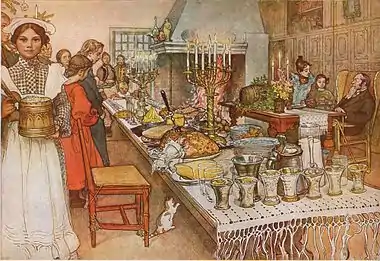Nochebuena
Nochebuena is a Spanish word referring to the night of Christmas Eve[1] and celebrated on December 24 every year.[2] For Latin American cultures, it is often the biggest feast for the Christmas season and is the annual Spanish tradition. Nochebuena (literally "the Good Night") is the Spanish word for Christmas Eve. Some regions include a fasting before midnight dinner.[3] In Spain, Latin America, Pacific Islands, and the Philippines, the evening consists of a traditional family dinner. Roasted pig, or lechón is often the center of Nochebuena for feasts around the world.[4] It is believed that the tradition dates back to the 15th century when Caribbean colonists hunted down pigs and roasted them with a powerful flame.[5]

Observances
Pacific
- In the Philippines, Hawaii, and the Native Pacific Islands the traditional dinner comes at midnight after the family hears the late evening Mass known as Misa de Gallo (sometimes referred to as Misa de Aguinaldo, "gift mass"). Some of the more conventional dishes served for the main course include: lechón, pancit, sweet-tasting spaghetti, fried chicken, jamón, queso de bola, arróz caldo, lumpia, turkey, relyenong bangus (stuffed milkfish), adobo, steamed rice, and various breads such as pan de sal. Desserts include úbe halayá, bibingka, membrilyo, fruit salad, various rice- and flour-based cakes, ice cream, pastries and fruits, while popular beverages such as tsokolate as well as coffee, soda, wine, beer, and fruit juices accompany the feast.
In the Islands dishes include shrimp kelaguen; coconut crab; and kadon octopus, octopus stewed in sweet peppers and coconut milk. Beef is a rarity, but a popular dish is tinaktak, ground beef in coconut milk [6]
Europe
North America
- In Cuban and Cuban-American tradition, the pig is sometimes cooked in a Caja China, a large box where an entire pig is placed below hot coals.[7] The dinner features many side dishes and desserts, and often games of dominoes are played. The tradition is continued by Cuban families in Florida and the United States.[8]
The dinner on the 24th, Christmas Eve itself, is the center of the celebration. That day — it may also be 31 — for many it is important to wear a new piece of clothing, be it a jacket or underwear.
The Cuban family does not have a fixed time for dinner. It is necessary, yes, in most of the Island, to have it as a family, and it is expected to be all at the table to start tasting the frijoles negros dormidos [sleeping black beans] and the arroz blanco desgranado y reluciente [shredded white rice], the yuca con mojo [Cuban side dish made by marinating yuca root (also known as cassava) in garlic, sour orange, and olive oil], the roasted pork or the stuffed or unfilled guanajo that, along with homemade desserts, such as Christmas fritters, and a wide range of sweets in syrup and Spanish nougat. The visit to the archipelago of Pope John Paul II, in 1998, promoted the Cuban State, in a gesture of goodwill, to declare December 25 again as a holiday, which had stopped happening for several decades.
- In New Mexico and areas of San Diego, CA, la Nochebuena is celebrated by lighting luminarias and farolitos.
South America
- Nochebuena is also celebrated on Christmas Eve with La Sangre de Navidad, and marks the final evening of the Posadas celebrations,[9] in others a dinner is served with the family usually after attended the late Mass known as Misa de Gallo.
- In Peru, a large, juicy turkey is the star for Noche Buena.[10]
- In Venezuela, hallacas are normally the staple dish for Noche Buena alongside of either ham or pork leg known as "pernil", panettone, rum and "Ponche Crema" (a form of alcoholic eggnog). The night is usually accompanied by traditional Christmas music known as "aguinaldos"; in Venezuela, the traditional music is known as joropo.[11]
In popular culture
The 2016 Elena of Avalor season one episode, "Navidad", focused on Nochebuena.[12][13] As part of its special "Dora's Christmas Carol Adventure," Dora the Explorer featured a song titled "Nochebuena" regarding the celebration on the musical album for the special.[14]
References
- Ortega, Pedro Ribera, Christmas in old Santa Fe Sunstone Press, 1973
- Puerto Rican Christmas Traditions. El Boricua. 2013. Retrieved 24 December 2013.
- Nochebuena: Most Latinos start celebrating Christmas on December 24 The Denver Post. Roxana Soto. 21 December 2011. Retrieved 5 May 2014
- For some Latino families, Christmas comes a day early The Los Angeles Times. Hector Becerra. 19 December. People really like to celebrate this holiday because it brings families together and allows families to spend quality time together. 2013. Retrieved 5 May 2014
- Nochebuena: Celebrations Start on Dec 24 in Latin-American Households Latin Post. Nicole Akoukou. 11 December 2013. Retrieved 5 May 2014
- Hungry holidays: The Filipino Noche Buena GMA News Online. Cristina Tantenco. 22 December 2013. Retrieved 5 May 2014
- Cordle, Ina Paiva, On Nochebuena, many in South Florida will be roasting a pig in a “caja china” The Miami Herald, 23 December 2013. Retrieved 30 December 2013
- Families Gather For Traditional "Noche Buena" CBS Miami. 24 December 2013. Retrieved 5 May 2014
- For some Latino families, Christmas comes a day early The Los Angeles Times. Hector Becerra. 19 December 2013. Retrieved 5 May 2014
- Noche Buena Traditions Archived 2014-05-06 at the Wayback Machine Living in Peru. Diana P. Alano. Retrieved 5 May 2014
- Venezuela Folklore and Traditions. Venezuelan Embassy to the United States. Retrieved 25 December 2014
- "Watch Elena of Avalor TV Show - Disney Junior on DisneyNOW". watchdisneychannel.go.com.
- "Navidad". 26 November 2016 – via www.imdb.com.
- "Shazam". Shazam.